|
|
|
|
|
Oil On
Canvas, Real Flavor of Old Masters
|
|

|
ARTWORKS
INDEX
A B C D E F G H I J K L M N O P Q R S T U V W X Y Z |
ARTISTS
INDEX
A B C D E F G H I J K L M N O P Q R S T U V W X Y Z |
|
|
| | |
|
|
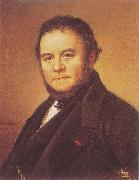 |
Johan Olaf Sodermark -- Click Here
|
|
painted Henri Beyle in 1840
|
|
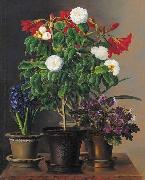 |
Johan Laurentz Jensen -- Click Here
|
|
(8 March 1800, Gentofte - 26 March 1856, Copenhagen) was a Danish artist who specialized in flower painting.
In parallel with his studies at the Danish Academy, he became a pupil of Christoffer Wilhelm Eckersberg and also of Cladius Detlev Fritzsch. Specializing in flower painting, Jensen continued his education in Paris under the Flemish flower painting brothers, Gerard and Cornelis van Spaendonck, and at the porcelain factory in Sevres where he learnt the art of miniature flower painting. Taking 17th-century Dutch flower painting as a starting point, he revived the art in Denmark. His floral arrangements often had both a decorative and symbolic value. Danish plants were often accompanied by exotic flowers and fruits, sometimes even birds. He also became head artist at the Danish Procelain Factory. Jensen had an extensive circle of customers and many students, especially women, including Louise of Hesse-Kassel who later married King Christian IX. Since the 1980s, his works have gained wide international recognition. Many are exhibited in Statens Museum for Kunst and in Thorvaldsens Museum. |
|
 |
johan krouthen -- Click Here
|
|
född 2 november 1858, död i december 1932, var en svensk idealistisk konstnär.
Krouthen föddes i Linköping och var son till handlaren Conrad Krouthen och Hilda Åberg. Släkten Krouthen kom från Norrköping och flera generationer hade arbetat som tenngjutare. Familjenamnet Krut ändrades genom att varubeteckningen Krut-tenn förfranskades till Krouthen. Conrad Krouthen kom till Linköping 1850 och startade en manufakturaffär vid Stora torget. Affären gick bra och 1857 kunde han gifta sig med sömmerskan Hilda Åberg.
Krouthen kunde växa upp i ett välmående hem och han fick börja skolan på läroverket i Linköping. Vid 14 års ålder slutade han skolan och började arbeta åt fotografen och målaren Svante Leonard Rydholm som hade en atelje vid St. Larsplan. Krouthen fick lära sig grunderna i både målning och fotografering och vid 16 års ålder började han på Konstakademiens principskola i Stockholm 1875. Den treåriga utbildningen innebar att eleverna fick lära sig att rita av klot och profiler, djur och växter. Efter de tre åren fick Krouthen fortsätta vid akademin. I kursen "Lägre antiken" fick eleverna rita av gipsmodeller, i "Högre antiken" teckna efter levande model och i "Landskapsskolan" fick eleverna måla landskap. Under studietiden sökte sig många elever utanför skolan och Krouthen lärde känna konstnären Edvard Perseus. Perseus var kritisk till utbildningen på akademin och tog med sina elever bland annat till Mariefred och Gripsholms slott för att måla av naturen. |
|
|
|
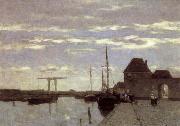 |
Johan Hendrik Weissenbruch -- Click Here
|
|
Dutch Painter, 1824-1903
Painter, cousin of Jan Weissenbruch. He referred to himself and signed his work as Jan Hendrik Weissenbruch. From 1840 he attended drawing lessons with the Norwegian painter Johannes Lew, and from 1846 he was taught by Bartholomeus J. van Hove at the Koninklijke Academie van Beeldende Kunsten in The Hague. His early paintings clearly show the influence of van Hove and Andreas Schelfhout, although it is uncertain whether he was actually taught by the latter. His father, an avid collector, owned works by both artists. |
|
|
|
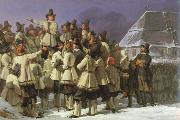 |
johan gustaf sandberg -- Click Here
|
|
Johan Gustaf Sandberg, född 1782, död 1854, var målare; han var professor i teckning vid Konstakademien från 1828, och direktör där 1845?C1853.
Sandberg ägnade sig främst åt historiemåleri, med motiv ur nordisk mytologi och svensk historia. Hans främsta verk inom detta område är kalkmålningarna över Gustav Vasa i Uppsala domkyrka. Han målade också en mängd porträtt.
Sandberg blev 1794 elev i konstakademins principskola och 1801 i antikskolan, lärde samtidigt musik och klaverspelning och tjänade pengar genom lektioner och genom arbete på kungliga teaterns dekorationsmålarverkstad. Under den följande tiden slöt han sig till den opposition mot akademin, som hade sin medelpunkt i "Sällskapet för konststudium". Tvisten med akademin lade sig snart, Sandberg valdes till ledamot 1821 och blev ordinarie professor 1828. Däremot hade han aldrig tillfälle att göra den för äldre tiders konstnärer obligatoriska studieresan till södern.
Han utförde teckningarna till praktverket "Ett år i Sverige" (1827 -35) med bilderna graverade under Christian Didrik Forssells ledning och texten skriven av Anders Abraham Grafström. Under upprepade sommarvistelser på Säfstaholms slott målade Sandberg folktyper och folkdräkter.
Åtskilliga porträtt utförde Sandberg för det praktfulla "Galleri af utmärkta svenska lärde, vetenskapsidkare och konstnärer", som han utgav 1835?C42 (100 porträtt, litograferade av J. Cardon).
|
|
 |
Johan Fredrik Krouthen -- Click Here
|
|
Swedish, 1858-1932 |
|
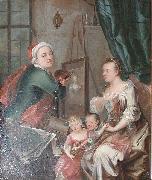 |
Johan Frederik Gerhard -- Click Here
|
|
painted Self-portrait in 1754 |
|
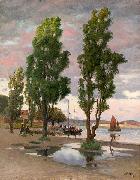 |
Johan Ericson -- Click Here
|
|
painted Parken i Marstrand in 1908 |
|
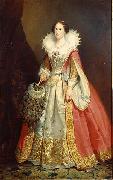 |
Johan Christoffer Boklund -- Click Here
|
|
(15 July 1817 - 9 December 1880) was a Swedish history, genre, and portrait painter from Kulla-Gunnarstorp in Scania.He was the son of a gardener. At the age of fifteen, Boklund came to Lund, where he worked on illustrations for Sven Nilsson's works on Scandinavian fauna (under the supervision of Magnus Körner). He then became a student at the Royal Danish Academy of Fine Arts in Copenhagen where J. L. Lund was his teacher.
In 1837, Boklund went to Stockholm and began studying at the Royal Swedish Academy of Arts. He made a living as a lithograph and drawing teacher, and produced several small genre paintings of the everyday life (such as Flicka med blomster (English: Girl with flowers) and Köksinteriör (English: Kitchen interior)) and history paintings of the 17th century (such as Gustaf Adolfs afsked från Maria Eleonora (English: Gustaf Adolf's farewell from Maria Eleonora), which was awarded with a medal at the academy).
Together with fellow Swedish painter Johan Fredrik Höckert, Boklund traveled to Munich in Germany in 1846 and stayed there for eight years. During the summers he went on study trips to Bavaria, Tyrol, and northern Italy. During this period, Boklund primarily devoted his painting to the history genre with subjects from the 17th century, but he also made some paintings depicting picturesque and architectural interior. In 1853, he sent his painting Den nyfikne trumpetaren (English: The curious trumpet player) home to Sweden and it earned him a scholarship from the government. This allowed Boklund to move to Paris, where he worked at Thomas Couture's atelier from 1854 to 1855. In December 1855 he returned to Sweden. |
|
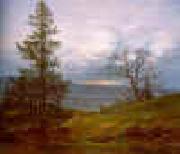 |
Johan Christian Dahl -- Click Here
|
|
1788-1857
Norwegian
1857). Norwegian painter and collector, active in Germany. His paintings, imbued with Romantic and patriotic sentiments, had a strong influence on the landscape tradition both in Germany (especially Dresden) and in his native Norway. |
|
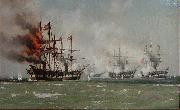 |
Johan Carl Neumann -- Click Here
|
|
painted Johan Carl Neumann in 1864 |
|
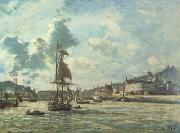 |
Johan Barthold Jongkind -- Click Here
|
|
Dutch Impressionist Painter, 1819-1891
was a Dutch painter and printmaker regarded as a forerunner of Impressionism who influenced Claude Monet. Jongkind was born in the town of Lattrop in the Overijssel province of the Netherlands near the border with Germany. Trained at the art academy in The Hague, in 1846 he moved to the Montmartre quarter of Paris, France where he studied under Eugene Isabey and Francois-Edouard Picot. Two years later, the Paris Salon accepted his work for its exhibition, and he received acclaim from critic Charles Baudelaire and later on from Emile Zola. Jongkind was to experience little success, however, and he suffered bouts of depression complicated by alcoholism. Jongkind returned to live in Rotterdam in 1855, and remained there until 1860. Back in Paris, in 1861 he rented a studio on the rue de Chevreuse in Montparnasse where some of his paintings began to show glimpses of the Impressionist style to come. In 1862 he befriended the young Claude Monet who later referred to Jongkind as the "master." The following year Jongkind exhibited at the first Salon des Refus's. Despite several successes, in another of his down periods the Impressionist group did not accept his work for their first exhibition in 1874. |
|
|
|
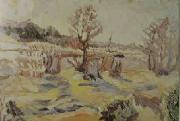 |
Joel Pettersson -- Click Here
|
|
(June 8, 1892 - January 5, 1937) was a painter and writer on the Åland Islands, Finland. He remained an obscure figure during his lifetime; most of his works were unpublished for decades after his death.
Pettersson was born into poverty in Lemland, Åland. His parents were elderly peasants, Joel's father being well over 50 at the time of Joel's birth. Joel had a younger brother Karl, who died at sea in 1916.
Pettersson began writing and painting in his early school years, though much of his works from this period were not preserved.
In 1913, he had the opportunity to study at a drawing school in Turku. He stayed in Turku until 1915, when he decided to abort his studies and return to Åland. He painted for a few years, but he eventually tired of it and did not paint for many years.
Upon his return, Pettersson became active in the local youth organisation, for which he wrote plays and monologues. He also wrote prose which he read out loud during organisation meetings. Pettersson was most active as a writer following his return from Turku until 1921.
During the 1920s, Pettersson worked mostly on his parents' farm, only sporadically participating in the youth organisation's activities. His parents both died in 1928, leaving Pettersson to care for the farm. He sold all the animals and most of the property. He tried earning a living on his artistry, but was unsuccessful. He then tried raising hens, but this also proved to be an unsuccessful venture. He resumed painting in 1935, and some of his paintings were displayed during an exhibition the following year.
His constant economic difficulties and work load took their toll. In 1936, he suffered a nervous breakdown and was committed to Grelsby Asylum, where he remained until his death in early 1937. |
|
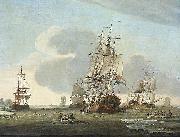 |
Jochem de Vries -- Click Here
|
|
painted The Zaandam shipping company Claes Tan en Zns Greenland farer Zaandam whaling in 1772
|
|
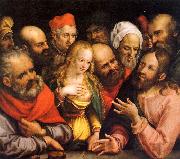 |
Jobst Harrich -- Click Here
|
|
German
1586-1617
Jobst Harrich Gallery |
|
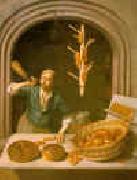 |
Job Berckhyde -- Click Here
|
|
1630-1693
Dutch
Job Berckhyde Gallery |
|
 |
Job Berckheyde -- Click Here
|
|
Dutch Baroque Era Painter, 1630-1693 |
|
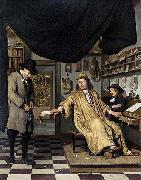 |
Job Adriaenszoon Berckheyde -- Click Here
|
|
(27 January 1630 - 10 June 1698) was a Dutch artist of the 17th century, active in Haarlem, Amsterdam, and The Hague.
Job Berckheyde was born in Haarlem and was the older brother of the painter Gerrit who he later taught to paint. He was apprenticed on 2 November 1644 to Jacob Willemszoon de Wet, and his master's influence is apparent in his first dated canvas, "Christ Preaching to the Children" (1661), one of his few biblical scenes. On 10 June 1653 he repaid a loan from the Haarlem Guild of Saint Luke. From 1656-1660 the two brothers made an extended trip along the Rhine to Germany, stopping off at Cologne, Bonn, Mannheim and finally Heidelberg, following the example of their fellow guild member Vincent van der Vinne. The brothers worked in Heidelberg for Charles I Louis, Elector Palatine (with Job producing portraits and hunting scenes, and receiving a gold chain from the Elector in reward) but were ultimately unable to adapt to court life and so returned to Haarlem, where they shared a house and perhaps a studio. He became a member of the Haarlem rederijkersgilde 'De Wijngaardranken' in 1666-1682. He is registered in Amsterdam 1682-1688, where he became a member of the Guild of St Luke there in 1685-1688.Berckheyde was buried in Haarlem. |
|
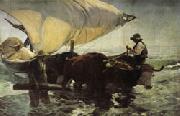 |
Joaquin Sorolla Y Bastida -- Click Here
|
|
Spanish Realist/Impressionist Painter , 1863-1923
Spanish painter, b. Valencia. He is noted for his large landscapes in full, glowing sunlight, painted in strong color and in a bold, fluent style. Sorolla's best-known works include Beaching the Boat and The Swimmers. |
|
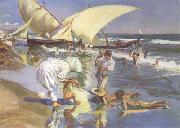 |
Joaquin Sorolla -- Click Here
|
|
Spanish Realist/Impressionist Painter, 1863-1923 |
|
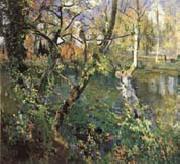 |
Joaquin Mir Trinxet -- Click Here
|
|
Spanish , 1873-1940 |
|
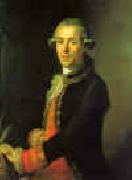 |
Joaquin Inza -- Click Here
|
|
1750-1820
Spanish
Joaquin Inza Gallery |
|
 |
Joaquin Agrasot y Juan -- Click Here
|
|
1837-1919
Spanish
Joaquin Agrasot y Juan Gallery |
|
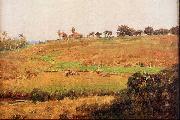 |
Joao Batista da Costa -- Click Here
|
|
painted Landscape in 1920 |
|
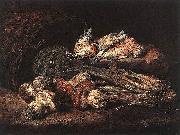 |
Joannes Fijt -- Click Here
|
|
(15 March 1611 - 11 September 1661) was a Flemish Baroque animal painter and etcher.
Fyt was born in Antwerp, where he was baptized on 15 June 1611, he was registered in 1621 as apprentice to Hans van den Berghe, who was a restorer of old pictures rather than a painter of new ones. Fyt then trained with Frans Snyders between about 1629-31, during which time, at the age of twenty, he entered the guild of St Luke as a master. From then until his death in 1661, he produced a vast number of paintings in which the bold facility of Frans Snyders is united to the powerful effects of Rembrandt, and harmonies of gorgeous tone are not less conspicuous than freedom of touch and a true semblance of nature.
He left Antwerp for Paris in 1633, travelling on to Italy the following year, where he worked in Venice and probably visited Rome (as he later joined the Guild of Romanists back in Antwerp). By 1641 he was back in Antwerp, where he married in 1654.
Hunting trophiesFyt excelled in the rendering of animal life in its most varied forms. He may have been less correct in outline, less bold in action than Snyders, but he was much more skilful and more true in the reproduction of the coat of deer, dogs, greyhounds, hares and monkeys, whilst in realizing the plumage of peacocks, woodcocks, ducks, hawks, and cocks and hens, he had no equal, nor was any artist even of the Dutch school more effective in relieving his compositions with accessories of tinted cloth, porcelain ware, vases and fruit.
He was not clever at figures, and he sometimes trusted for these to the co-operation of Cornelius Schut or Thomas Willeboirts Bosschaert, whilst his architectural backgrounds were sometimes executed by Quellyn. Silenus amongst Fruit and Flowers, in the Harrach collection at Vienna, Diana and her Nymphs with the Produce of the Chase, in the Belvedere at Vienna, and Dead Game and Fruit in front of a Triumphal Arch, belonging to Baron von Rothschild at Vienna, are specimens of the co-operation respectively of Schut, Willeborts and Quellyn. They are also Fyt's masterpieces. The earliest dated work of the master is a cat grabbing at a piece of dead poultry near a hare and birds, belonging to Baron Cetto at Munich, and executed in 1644. The latest is a Dead Snipe with Ducks, of 1660, sold with the Jäger collection at Cologne in 1871.
Great power is shown in the bear and boar hunts at Munich and Ravensworth castle. A Hunted Roedeer with Dogs in the Water, in the Berlin Museum, has some of the life and more of the roughness of Snyders, but lacks variety of tint and finish. A splendid specimen is the Page and Parrot near a table covered with game, guarded by a dog staring at a monkey, in the Wallace collection. With the needle and the brush Fyt was equally clever. He etched 16 plates, and those representing dogs are of their kind unique.
|
|
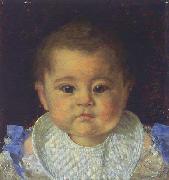 |
Joanna Mary Boyce -- Click Here
|
|
Joanna Mary Boyce, also known as Mrs. H. T. Wells, her married name, (7 December 1831 - 15 July 1861) was an English painter of portraits, genre pictures, and occasionally landscapes. She was the sister of pre-Raphaelite watercolorist George Price Boyce, and was herself associated with the Brotherhood.
|
|
 |
Joan de Joanes -- Click Here
|
|
Spanish Painter
1507-1579 |
|
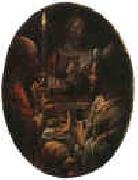 |
Joachim Wtewael -- Click Here
|
|
1566-1638 Flemish Joachim Wtewael Galleries
Dutch painter and draughtsman. He was one of the last exponents of MANNERISM. From c. 1590 until 1628, the year of his latest known dated paintings, he employed such typical Mannerist formal devices as brilliant decorative colour, contrived spatial design and contorted poses. He sometimes combined such artifice with naturalism, and this amalgam represents the two approaches Dutch 16th- and 17th-century theorists discussed as uyt den geest (from the imagination) and naer t leven (after life). Wtewaels activity reflects the transition from Mannerism to a more naturalistic style in Dutch art. Slightly over 100 of his paintings and about 80 drawings are known. Subjects from the Bible and mythology predominate; he also painted several portraits, including a Self-portrait (1601; Utrecht, Cent. Mus.). |
|
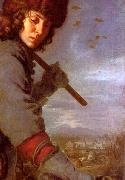 |
Joachim von Sandrart -- Click Here
|
|
(12 May 1606 - 14 October 1688) was a German Baroque art-historian and painter, active in Amsterdam during the Dutch Golden Age.
Sandrart was born in Frankfurt, but the family originated from Mons. According to Houbraken (who used his Teutsche Akademie as a primary source), he learned to read and write from the son of Theodor de Bry, Johann Theodoor de Brie and his associate Matthäus Merian, but at age 15 was so eager to learn more of the art of engraving, that he walked from Frankfurt to Prague to become a pupil of Gillis Sadelaar (also known as Aegidius Sadeler of the Sadeler family). Sadelaar in turn urged him to paint, whereupon he travelled to Utrecht in 1625 to become a pupil of Gerrit van Honthorst, and through him he met Rubens when he brought a visit to Honthorst in 1627, to recruit him for collaboration on part of his Marie de' Medici cycle. Honthorst took Sandrart along with him when he travelled to London. There he worked with Honthorst and spent time making copies of Holbein portraits for the portrait gallery of Henry Howard, 22nd Earl of Arundel.
Making all of those copies only served to arouse more curiosity in the young adventurer, and in 1627 Sandrart booked a passage on a ship from London to Venice, where he was welcomed by Jan Lis (whose Bentvueghels bent name was "Pan"), and Nicolaas Ringnerus. He then set out for Bologna, where he was met by his cousin on his father's side Michael le Blond, a celebrated engraver. With him, he crossed the mountains to Florence, and from there on to Rome, where they met Pieter van Laer (whose bent name was "Bamboccio"). Sandrart became famous as a portrait-painter. After a few years he undertook a tour of Italy, traveling to Naples, where he drew studies of Mount Vesuvius, believed to be the entrance to the Elysian fields described by Virgil. From there he traveled to Malta and beyond, searching for literary sights to see and paint, and wherever he went he paid his way by selling portraits. Only when he was done traveling did he finally return to Frankfurt, where he married Johanna de Milkau.
Afraid of political unrest and plague, he moved to Amsterdam with his wife in 1637.
|
|
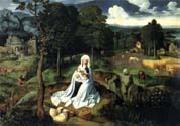 |
Joachim Patinir -- Click Here
|
|
Flemish Northern Renaissance Painter, ca.1485-1524 |
|
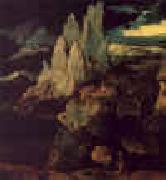 |
Joachim Patenier -- Click Here
|
|
1480-1525
Flemish
Joachim Patenier Galleries
was a Flemish Northern Renaissance history and landscape painter. He was probably the uncle of Herri met de Bles, with whom he helped establish a distinct style of northern Renaissance landscapes. |
|
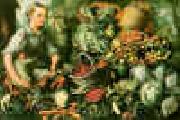 |
Joachim Beuckelaer -- Click Here
|
|
1535-1574
Flemish
Joachim Beuckelaer Galleries
b Antwerp, c. 1534; dAntwerp, c. 1574). Flemish painter. He came from an Antwerp family of obscure painters and seems to have spent his entire life there. He trained in the studio of Pieter Aertsen, who in 1542 had married Beuckelaers aunt; he became an independent master and also married in 1560. His earliest known work dates from that year, and his development can be followed closely to 1570. The example of Beuckelaers master remained decisive throughout his career. Not only did he take over Aertsens new repertory of secular subjects, he also completely adopted his stylistic idiom and manner of painting, so that it can be difficult to distinguish the two hands. Beuckelaer was, however, by no means a slavish imitator, and as regards execution he fully bears comparison with Aertsen. |
|
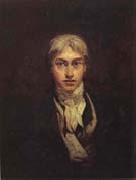 |
Jmw Turner -- Click Here
|
|
1775-1851
British landscape painter. The son of a barber, he entered the Royal Academy school in 1789. In 1802 he became a full academician and in 1807 was appointed professor of perspective. His early work was concerned with accurate depictions of places, but he soon learned from Richard Wilson to take a more poetic and imaginative approach. The Shipwreck (1805) shows his new emphasis on luminosity, atmosphere, and Romantic, dramatic subjects. After a trip to Italy in 1819, his colour became purer and more prismatic, with a general heightening of key. In later paintings, such as Sunrise, with a Boat Between Headlands (1845), architectural and natural details are sacrificed to effects of colour and light, with only the barest indication of mass. His compositions became more fluid, suggesting movement and space. In breaking down conventional formulas of representation, he anticipated French Impressionism. His immense reputation in the 19th century was due largely to John Ruskin's enthusiasm for his early works |
|
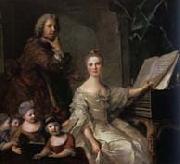 |
Jjean-Marc nattier -- Click Here
|
|
French Rococo Era Painter, 1685-1766 |
|
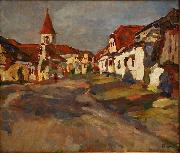 |
Jindrich Prucha -- Click Here
|
|
painted Village Green in 1910 - 1911
|
|
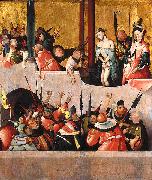 |
Jheronimus Bosch -- Click Here
|
|
c. 1450 - 9 August 1516), was a Dutch painter. His work is known for its use of fantastic imagery to illustrate moral and religious concepts and narratives.
Hieronymus Bosch was born Hieronymus (or Jeroen, respectively the Latin and Middle Dutch form of the name "Jerome") van Aken (meaning "from Aachen"). He signed a number of his paintings as Bosch (pronounced Boss in Middle Dutch). The name derives from his birthplace, 's-Hertogenbosch, which is commonly called "Den Bosch".
Little is known of Bosches life or training. He left behind no letters or diaries, and what has been identified has been taken from brief references to him in the municipal records of 's-Hertogenbosch, and in the account books of the local order of the Brotherhood of Our Lady. Nothing is known of his personality or his thoughts on the meaning of his art. Bosches date of birth has not been determined with certainty. It is estimated at c. 1450 on the basis of a hand drawn portrait (which may be a self-portrait) made shortly before his death in 1516. The drawing shows the artist at an advanced age, probably in his late sixties
|
|
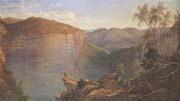 |
JH Carse -- Click Here
|
|
Australian Painter, ca.1819-1900 |
|
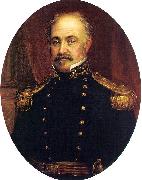 |
Jewett, William Smith -- Click Here
|
|
American, 1792-1874 |
|
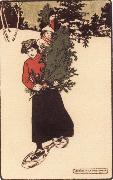 |
Jessie Willcox Smith -- Click Here
|
|
American Golden Age Illustrator, 1863-1935
was an American illustrator famous for her work in magazines such as Ladies Home Journal and for her illustrations for children's books. Born in the Mount Airy neighborhood of Philadelphia, Pennsylvania, Smith studied at the Pennsylvania Academy of the Fine Arts under Thomas Eakins in Philadelphia, graduating in 1888. A year later, she started working in the production department of the Ladies Home Journal, for five years. She left to take classes under Howard Pyle, first at Drexel and then at the Brandywine School. Jessie Willcox Smith, Illustration for The Water-Babies (1916)She was a prolific contributor to books and magazines during the late nineteenth and early twentieth centuries, illustrating stories and articles for clients such as Century, Collier's Weekly, Leslie's Weekly, Harper's, McClure's, Scribners, and the Ladies' Home Journal. Smith may be most well known for her covers on Good Housekeeping, which she painted from December 1917 through March 1933. She also painted posters and portraits. Her twelve illustrations for Charles Kingsley's The Water Babies (1916) are also well known. On Smith's death, she bequeathed the original works to the Library of Congress' "Cabinet of American Illustration" collection. Smith was close friends with the artists Elizabeth Shippen Green and Violet Oakley, |
|
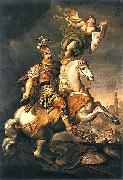 |
Jerzy Siemiginowski-Eleuter -- Click Here
|
|
(ca. 1660 - ca. 1711) was a prominent Polish painter and engraver of the Baroque, court painter of king John III Sobieski and a Polish-Lithuanian noble. He is considered one of the most accomplished painters of Classical Baroque in Poland, who joined in his works classical theory with genuine motives.
|
|
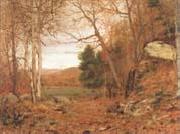 |
Jervis Mcentee -- Click Here
|
|
American Realist Painter, 1828-1891, He was an American painter of the Hudson River School. He is a somewhat lesser-known figure of the 19th century American art world, but was the close friend and traveling companion of several of the important Hudson River School artists. Aside from his paintings, McEntee's enduring legacy are the detailed journals he kept from the early 1870s until his death. In his writings McEntee records a detailed account of Hudson River School artists, their day-to-day life, gossip and personal reflections, and the overall arc of the American art world in the second half of the 19th century. He discusses his artistic successes and trials, particularly as money becomes more scarce with the decline in popularity of Hudson River School art. McEntee's journals are now kept by the Archives of American Art, a research center within the Smithsonian Institution. Five volumes of these diaries, from 1872 to 1890, have been digitally scanned, transcribed, and can be browsed in their entirety in the Jervis McEntee Diaries Online. McEntee was born in Rondout, New York on July 14, 1828. Little is known of his childhood. He exhibited his first painting at the National Academy of Design in New York City in 1850. |
|
|
|
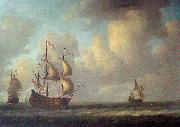 |
Jeronymus van Diest -- Click Here
|
|
(1631, The Hague - ca.1687, The Hague), was a Dutch Golden Age seascape painter.
According to Houbraken, a Jeronymus van Diest was good with grisailles and was the teacher of Adriaen van de Venne.[1] This grisaille painter Jeronymus Diest (I) may possibly have been a grandfather of the younger Jeronymus Diest (II); since they are both from the Hague.
According to the RKD this younger Jeronymus Diest (II) was the son of the painter Willem van Diest and the father of the painter Adriaen van Diest who was a follower of Jan van Goyen and Hendrik Dubbels.His known works are all seascapes with various ships at sail. |
|
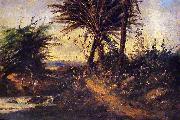 |
Jeronimo Jose Telles Junior -- Click Here
|
|
painted Landsape 1851-1914 |
|
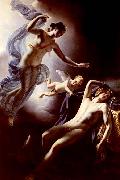 |
Jerome-Martin Langlois -- Click Here
|
|
French Academic Painter,
1779-1838 |
|
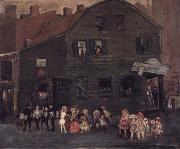 |
Jerome Myers -- Click Here
|
|
(March 20, 1867 - June 19, 1940) was a U.S. artist and writer. Born in Petersburg, Virginia and raised in Philadelphia, Trenton and Baltimore, he spent his adult life in New York City. Jerome worked briefly as an actor and scene painter, then studied art at Cooper Union and the Art Students League where his main teacher was George de Forest Brush. In 1896 and 1914, he was in Paris, but his main classroom was the streets of New York's lower East Side. His strong interest and feelings for the new immigrants and their life resulted in hundreds of drawings, as well as paintings and etchings capturing the whole panorama of their lives as found outside of the crowded tenements which were their first homes in America. |
|
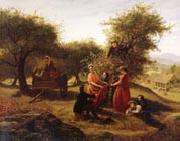 |
Jerome B Thompson -- Click Here
|
|
American Impressionist ,
1814-1886 |
|
 |
Jerg Ratgeb -- Click Here
|
|
Jerg Ratgeb (also Jörg) (born circa 1480 in Schwäbisch Gmend; died 1526 in Pforzheim) was a German painter and contemporary of Derer.
Around the turn of the 15th to 16th century, Ratgeb appears to have spent time in Italy, where he came in contact with Italian Renaissance art and with the recently developed use of perspective in painting. After returning to Germany, he settled in Heilbronn. In 1510, he painted the altar of Saint Barbara in the church of nearby Schwaigern.
From 1514 to 1517 he was in Frankfurt am Main, where he painted the walls of the refectory and cloister of the Karmeliterkloster (Carmelite Monastery). The paintings, of which only fragments survive, are the largest wall paintings known to the north of the Alps from that period. His most famous work is the Herrenberg Altarpiece, completed in 1521. It was originally painted for the Stiftskirche (abbey church) of Herrenberg. Today, it is on display in the Staatgalerie at Stuttgart. Ratgeb had developed a distinctive personal expressive style, visibly influenced by artists such as Albrecht Derer, Matthias Grenewald and Hieronymus Bosch.
Fresco in the Karmeliterkloster, Frankfurt am Main.
Copy of the altarpiece in the abbey church at Herrenberg - here depicted when closed
Because of his marriage with a serf of the Duke of Werttemberg he lost most of his rights as a citizen of Heilbronn. He moved to Stuttgart, where he became a member of the city council. In that position, he negotiated with the rebelling farmers during the German Peasants' War in 1525. He became part of the military contingent requested by the rebels and was elected councillor and chancellor by the peasants. After the suppression of the rebellion, he was arrested, accused of high treason ("because of the Peasant War and on behalf of Duke Ulrich") and finally executed in Pforzheim in 1526, by being torn apart by four horses. |
|
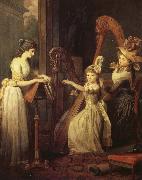 |
jeremy collier -- Click Here
|
|
1650 C 1726, English clergyman. Collier was imprisoned as one of the nonjurors, who refused to pledge allegiance to William III and Mary II. He later was outlawed (1696) for absolving on the scaffold two of those involved in the assassination plot against William. Collier's principal fame comes from his Short View of the Immorality and Profaneness of the English Stage (1698) and Ecclesiastical History of Great Britain (1708, 1714). In 1713 he was ordained a nonjuring bishop. |
|
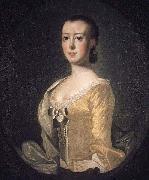 |
Jeremiah Theus -- Click Here
|
|
(April 5, 1716 - May 17, 1774) was a Swiss-born American painter, primarily of portraits. He was active mainly around Charleston, South Carolina, in which city he remained almost without competition for the bulk of his career.
Theus was born in the city of Chur, in the Swiss canton of Graubenden, and was the eldest child of Simeon and Anna Walser Thees. He was nineteen when he immigrated with his family to the Province of South Carolina, whose General Assembly had provided land grants and transport funds to encourage European Protestants to settle in the colony. Simeon Thes was given 250 acres (1.0 km2) of land along the Edisto River in what was then Orangeburgh Township, |
|
|
|
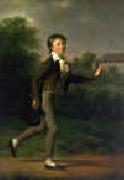 |
Jens Juel -- Click Here
|
|
1745-1802
Danish
Jens Juel Galleries
was a Danish painter, primarily known for his many portraits, of which the largest collection is on display at Frederiksborg Castle.
He was born in the house of his mothers brother Johan Jørgensen, who was a school teacher in Balslev on the island of Fyn. Jens Juel was the illegitimate son of Vilhelmine Elisabeth Juel (January 1725 ?C March 1799), who served at Wedellsborg and a fine gentleman, probably a Wedell or Lord Jens Juel. When Juel was one year old, his mother married Jørgen Jørgensen (1724 ?C June 4, 1796), who was a school master in Gamborg, not far from Balslev, and he grew up in Gamborg.
He showed an interest in painting from an early age, and his parents sent him to be an apprentice of painter Johann Michael Gehrman in Hamburg, where he worked hard for five or six years and improved himself so far, that he created himself a reputation as a painter of portraits, landscapes, etc. Just over twenty years old he came to Copenhagen to attend the Royal Danish Academy of Art. In 1767 he was awarded its small gold medal and in 1771 the large gold medal.
In 1772 he left Copenhagen to be away for eight years. Initially, he went to Rome where he stayed for four years together with other Danish artists, including Abildgaard. From Rome, he moved to Paris, at the time a center of portrait painting. In 1777 he moved on to Geneva, where he stayed for two years at the home of his friend Charles Bonnet in the company of other Danish artists, including etcher Clemens. In Geneva, Juel soon earned himself a reputation as an excellent artist and he painted many portraits. Through Bonnet, who had become a member of honour of the Danish academy, his reputation reached Denmark. After eight years of absence, he returned to Copenhagen in 1780 after a brief stay in Hamburg, where he met Klopstock. It was at his house, that he painted his well-known picture of "Messiadens Digter". Back in Copenhagen, he created himself a reputation as a painter of portraits for the royal house, nobility and the well-to-do.
April 4, 1782, he was unanimously elected to be a member of the academy by Mandelberg, Weidenhaupt and Abildgaard. He became the director of the academy in 1795.
|
|
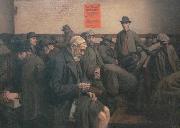 |
Jens Birkholm -- Click Here
|
|
painted Warmehalle in Berlin in 1908 |
|
|
|
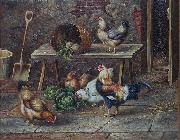 |
Jenny Hoppe -- Click Here
|
|
Jenny Hoppe (Dusseldorf, 1870 -Elsene, 1934) was een Duits-Belgische kunstschilderes.
|
|
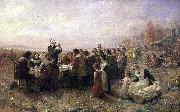 |
Jennie A. Brownscombe -- Click Here
|
|
Jennie Augusta Brownscombe
American, 1850-1936
She has been called "a kind of Norman Rockwell of her era." In fact, the skillful drawing, attention to detail, and nostalgic moods of her paintings make the comparison between Jennie Augusta Brownscombe and the popular American illustrator seem quite apt.
Brownscombe's early life sounds like the story behind one of her own pictures. Born in a log cabin in rural northeastern Pennsylvania, she was the only child of William Brownscombe, an English-born farmer, and Elvira Kennedy, a direct descendant of a Mayflower passenger, who encouraged her young daughter to write poetry and draw. Brownscombe won her first awards as a high school student, exhibiting her work at the Wayne County Fair. When her father died in 1868, Brownscombe began supporting herself through teaching, creating book and magazine illustrations, and selling the rights to reproduce her watercolor and oil paintings as inexpensive prints, Christmas cards, and calendars. More than 100 of Brownscombe's works were distributed this way, spreading her images into homes throughout the nation. |
|
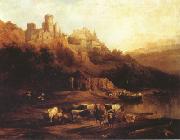 |
Jenaro Perez Villaamil -- Click Here
|
|
1807-1854
was born in Ferrol, Galicia. He was a remarkable painter and prime example of the Galician Romantic Movement. In his work, particularly in his landscapes, he shows an unmistakable taste for the English painters of the same period. Most of his paintings are exhibited at Museo del Prado in Madrid, the city where he died. |
|
 |
Jeles-Eugene Lenepveu -- Click Here
|
|
French Neoclassical Painter, 1819-1898.
Studied under François-Edward Picot. |
|
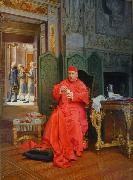 |
Jehan Georges Vibert -- Click Here
|
|
Jehan Georges Vibert (30 September 1840 - 28 July 1902) was a French academic painter.
He was born in Paris. He began his artistic training at a young age under the instruction of his maternal grandfather, engraver Jean-Pierre-Marie Jazet. Vibert was more interested in painting than engraving and entered the studio of Felix-Joseph Barrias and eventually the École des Beaux-Arts when he was sixteen. He remained at the École for six years under the instruction of historic painter François-Edouard Picot.
Vibert debuted at the Salon of 1863 with La Sieste (The Siesta) and Repentir (Repentance).
During the Franco-Prussian War, Vibert became a sharpshooter and was wounded at the battle of Malmaison in October 1870. He was awarded the Legion deHonneur and became a Chevalier de la Legion deHonneur in recognition of his sacrifice. He became an Officer of the Legion deHonneur in 1882.
|
|
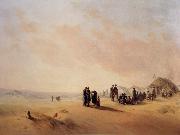 |
Jeanron Philippe Auguste -- Click Here
|
|
Boulogne-sur-Mer1809-Comborn 1877
|
|
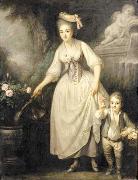 |
Jeanne-Philiberte Ledoux -- Click Here
|
|
painted Portrait of a lady, said to be the Duchesse de Choiseul in 18th century
|
|
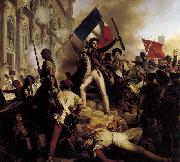 |
Jean-Victor Schnetz -- Click Here
|
|
1787-1870,was a French academic painter well-regarded for his historical and genre paintings. Schnez studied in Paris under Jacques-Louis David. His works can be found at the Louvre and the Petit Palais in Paris, the Hermitage in St. Petersburg, and the Museum of Fine Arts in San Francisco. In 1837 Schnetz was elected to the Academie des Beaux-Arts, and he was twice the Director of the French Academy in Rome, from 1841-1846 then again in 1853-1866 |
|
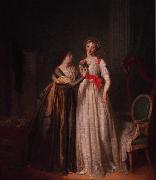 |
Jean-Simon Fournier -- Click Here
|
|
(1791-1799 ) - Painter |
|
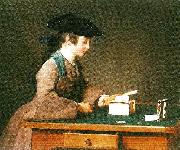 |
jean-simeon chardin -- Click Here
|
|
Jean-Baptiste-Simeon Chardin, född 2 november 1699 i Paris, död 6 december 1779 i Paris, var en fransk målare. Mästare på stilleben och genrebilder.
Chardins blygsamma läggning, personliga stil och valet av motiv från medelklassens vardagsliv försenade hans succe i Bouchers och Fragonards Frankrike, men 1728 invaldes han i Franska akademin samtidigt som hans genrebilder genom gravörernas försorg blev populära.
När 1700-talets hovkonst inte längre var populär, steg Chardins popularitet. De enkla kompositionerna, de ensamma gestalterna i form av köksflickor i arbete eller barn försjunkna i sina lekar, påverkade målare som på 1800-talet målade vardagsmotiv. Manet influerades starkt av den lugna klarheten i Chardins stilleben, liksom Courbet hade påverkats före honom. |
|
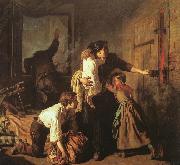 |
Jean-Pierre-Alexandre Antigna -- Click Here
|
|
painted The Fire in 1850-51
|
|
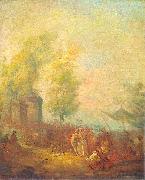 |
Jean-Pierre Norblin de La Gourdaine -- Click Here
|
|
(in Polish, Jan Piotr Norblin; 15 July 1745 - 23 February 1830) was a French-born painter, draughtsman, engraver, drawing artist and caricaturist. From 1774 to 1804 he resided in the Polish-Lithuanian Commonwealth, where he obtained citizenship.
He is considered one of the most important painters of the Polish Enlightenment. He achieved great success in Poland. Given many commissions from some of the most notable families of the Polish-Lithuanian Commonwealth, he stayed there for many years, not returning to Paris until the early 19th century. His style showed the influence of Antoine Watteau, and combined the Rococo tradition of charming fates galantes and fetes champetres with a panorama of daily life and current political events, captured with journalistic accuracy. He created a gallery of portraits of representatives of all social classes in the last years of the Polish-Lithuanian Commonwealth.
|
|
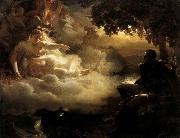 |
Jean-Pierre Franque -- Click Here
|
|
French, 1774-1860,French painter. He and his twin brother, Joseph-Boniface Franque (1774-1833), who was also a painter, were the sons of a modest farmer and, according to a local story, their youthful talent was such that the provincial government paid for them to study in Grenoble. They enrolled at the Ecole Gratuite in Grenoble and stayed for about two years (1786-8), training to become engravers. During the revolutionary period, the twins' education was taken over by the Departement de la Dreme. In 1792 their case was discussed at the National Assembly in Paris, which placed them in David's atelier and provided a pension for four years. David agreed to educate them but refused payment, writing to the President of the Assembly, 'I am overjoyed to be chosen to be the first teacher of these youths who could be called children of the nation since they owe everything to her.' The two brothers were considered very promising students, and David asked Jean-Pierre to assist him in the execution of the Intervention of the Sabine Women (1796-9; Paris, Louvre). Jean-Pierre also became involved with LES PRIMITIFS and the mysterious Maurice Quae (1779-1804), who reacted against Davidian principles and advocated a return to 'primitive' 15th-century Italian art. Franque demonstrated his independence from David in the selection of the subject for his 1806 Salon debut, the Dream of Love Induced by the Power of Harmony (destr.). In the spring of 1807 he was one of the 26 painters who entered a sketch (untraced) for the competition for a large painting representing Napoleon on the battlefield of Eylau, a competition won by Gros. In 1810 Franque produced Allegory of the Condition of France before the Return from Egypt (Paris, Louvre). |
|
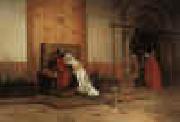 |
Jean-Paul Laurens -- Click Here
|
|
1838-1921
French
Jean Paul Laurens Gallery
was a French painter and sculptor, and one of the last major exponents of the French Academic style.
Born in Fourquevaux, he was a pupil of L??on Cogniet and Alexandre Bida. Strongly anti-clerical and republican, his work was often on historical and religious themes, through which he sought to convey a message of opposition to monarchical and clerical oppression. His erudition and technical mastery were much admired in his time, but in later years his hyper-realistic technique, coupled to a highly theatrical mise-en-sc??ne, came to be regarded as overly didactic and even involuntarily comical.
Laurens was commissioned to paint numerous public works by the French Third Republic, including the steel vault of the Paris city hall, the monumental series on the life of Saint Genevieve in the apse of the Panth??on, the decorated ceiling of the Od??on Theater, and the hall of distinguished citizens at the Toulouse capitol. He also provided illustrations for Augustin Thierry's R??cits des temps m??rovingiens ("Accounts of Merovingian Times").
Laurens was a professor at the École nationale sup??rieure des Beaux-Arts in Paris, where he taught Andr?? Dunoyer de Segonzac and George Barbier. Two of his sons, Paul Albert Laurens (1870-1934) and Jean-Pierre Laurens (1875-1932), became painters and teachers at the Acad??mie Julian. He died in Paris in 1921. |
|
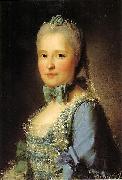 |
Jean-Martial Fredou -- Click Here
|
|
Jean-Martial Fredou (28 January 1710 e 1795) was a French painter known for his portraits.
Born at Fontenay-Saint-Pere, Fredou was attached to the Cabinet du Roi housed in the Hôtel de la Surintendance at Versailles, where he was commissioned to render duplicates of official portraits of the French royal family painted by Jean-Marc Nattier, Maurice Quentin de La Tour, Louis-Michel Van Loo, Alexander Roslin or Joseph Siffred Duplessis.
In his own commissions he often borrowed elements from the original works of these painters, for he was a deft portraitist himself. Between 1760 and 1762 the dauphine Marie-Josephe de Saxe, daughter-in-law of Louis XV commissioned informal portraits of herself and her children, for her own use. These portraits, whether in oil or drawn aux trois crayons, touched with pastels, have freshness and life.
A modest commission came from the Dauphin and Dauphine in 1757: in 1748 they had earth brought in to the little courtyard of their private apartments at the château de Versailles, closed in with trelliswork, to make a little garden; and Fredou was commissiomed to paint two perspective panels to enlarge the little space.[1]
Fredou was never made a member of the Academie Royale de Peinture et de Sculpture, but he was made First Painter to the comte de Provence in 1776 upon the death of François-Hubert Drouais.
|
|
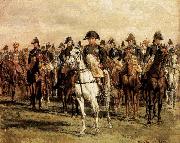 |
Jean-Louis-Ernest Meissonier -- Click Here
|
|
French Academic Painter, 1815-1891,French painter, sculptor and illustrator. Although he was briefly a student of Jules Potier (1796-1865) and Leon Cogniet, Meissonier was mainly self-taught and gained experience by designing wood-engravings for book illustrations. These included Leon Curmer's celebrated edition of J.-H. Bernardin de Saint-Pierre's Paul et Virginie (Paris, 1838), the series Les Franeais peints par eux-memes (Paris, 1840-42) and Louis de Chevigne's Les Contes remois (Paris, 1858). |
|
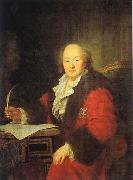 |
Jean-Louis Voille -- Click Here
|
|
painted Ivan Perfilevich Elagin in 1789 |
|
|
|
Jean-Louis prevost le jeune -- Click Here
|
|
Noitel circa
1740-after 1810
|
|
 |
Jean-Louis Hamon -- Click Here
|
|
Plouha 1821 - Saint - Raphael, 1874.
French Academic Painter, 1821-1874.
Studied under Charles Gleyre.
French Academic Painter, 1821-1874. Studied under Charles Gleyre. French painter and designer. He was encouraged to practise drawing by the Brothers of the Christian Doctrine at Lannion. Through the intervention of Felicite-Robert de Lamennais (1782-1854), he was made drawing-master at a religious seminary at Ploermel, Brittany, although at this stage he had received no instruction and had never seen an oil painting. In 1840 he asked his conseil general for help and left for Paris the following year with a grant of 500 francs. He went to Delaroche's studio, where he made friends with Picou, Jean-Leon Gereme, Jean Aubert (1824-1906) and Jean Eugene Damery (1823-53). Charles Gleyre, who took over Delaroche's studio in 1843, encouraged and protected him during years of poverty. |
|
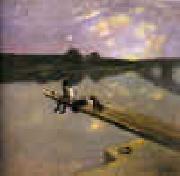 |
Jean-Louis Forain -- Click Here
|
|
1852-1931
French painter, printmaker and illustrator. Around 1860 he moved with his family to Paris, where he was taught by Jacquesson de la Chevreuse (1839-1903), Jean Baptiste Carpeaux and Andre Gill. He participated in the Franco-Prussian War (1870-71) and was a friend of the poets Paul Verlaine and Arthur Rimbaud; the latter is the presumed subject of a portrait (1874; priv. col., see 1982 exh. cat., no. 1) that may have influenced Manet late portrait of Mallarme (1876; Paris, Louvre). Forain first met Manet through his friendship with Degas in the early 1870s at the salon of Nina de Callias. He continued to associate with Manet, meeting the group of young Impressionists at the Cafe Guerbois and the Cafe de la Nouvelle Athenes. In 1878 Forain painted a small gouache, Cafe Scene (New York, Brooklyn Mus.), which probably influenced Manet Bar at the Folies-Bergere (1881-2; London, Courtauld Inst. Gals). |
|
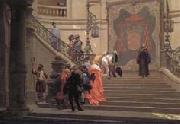 |
Jean-Leon Gerome -- Click Here
|
|
French Academic Painter and Sculptor, 1824-1904
was a French painter and sculptor in the style now known as Academicism. The range of his oeuvre included historical painting, Greek mythology, Orientalism, portraits and other subjects, bringing the Academic painting tradition to an artistic climax. Born at Vesoul (Haute-Saône), he went to Paris in 1840 where he studied under Paul Delaroche, whom he accompanied to Italy (1843-1844). He visited Florence, Rome, the Vatican and Pompeii, but he was more attracted to the world of nature. Taken by a fever, he was forced to return to Paris in 1844. On his return he followed, like many other students of Delaroche, into the atelier of Charles Gleyre and studied there for a brief time. He then attended the Ecole des Beaux-Arts. In 1846 he tried to enter the prestigious Prix de Rome, but failed in the final stage because his figure drawing was inadequate. He tried to improve his skills by painting The Cockfight (1846), an academic exercise depicting a nude young man and a lightly draped girl with two fighting cocks and in the background the Bay of Naples. He sent this painting to the Salon of 1847, where it gained him a third-class medal. This work was seen as the epitome of the Neo-Grec movement that had formed out of Gleyre's studio (such as Henri-Pierre Picou (1824-1895) and Jean-Louis Hamon), and was championed by the influential French critic Theophile Gautier. G??rôme abandoned his dream of winning the Prix de Rome and took advantage of his sudden success. His paintings The Virgin, the Infant Jesus and St John (private collection) and Anacreon, Bacchus and Cupid (Mus??e des Augustins, Toulouse, France) took a second-class medal in 1848. In 1849 he produced the paintings Michelangelo (also called In his studio) (now in private collection) image of the painting and A portrait of a Lady (Mus??e Ingres, Montauban). In 1851 he decorated a vase, later offered by Emperor Napoleon III of France to Prince Albert, now part of the Royal Collection at St. James's Palace, London. He exhibited Bacchus and Love, Drunk, a Greek Interior and Souvenir d'Italie, in 1851; Paestum (1852); and An Idyll (1853). In 1852 G??rôme received a commission by Alfred Emilien Comte de Nieuwerkerke, Surintendant des Beaux-Arts to the court of Napoleon III, for the painting of a large historical canvas, the Age of Augustus image of the painting. In this canvas he combines the birth of Christ with conquered nations paying homage to Augustus. Thanks to a considerable down payment, he was able to travel in 1853 to Constantinople, together with the actor Edmond Got. This would be the first of several travels to the East : in 1854 he made another journey to Turkey and the shores of the Danube, where he was present at a concert of Russian conscripts, making music under the threat of a lash. In 1854 he completed another important commission of decorating the Chapel of St. Jerome in the church of St. S??verin in Paris. His Last communion of St. Jerome in this chapel reflects the influence of the school of Ingres on his religious works. To the exhibition of 1855 he contributed a Pifferaro, a Shepherd, A Russian Concert, The Age of Augustus and Birth of Christ. |
|
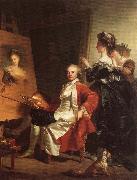 |
Jean-Laurent Mosnier -- Click Here
|
|
French portrait Painter , b. ca. 1743, Paris, d. 1808, St. Petersburg |
|
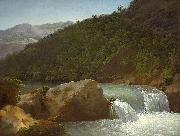 |
Jean-Joseph-Xavier Bidauld -- Click Here
|
|
(1758 - 1846) was a French painter.
A native of the city of Carpentras, Bidauld first studied painting with his elder brother, Jean-Pierre-Xavier, in Lyons. In 1783 he traveled to Paris, there winning the favor of an art dealer and perfume seller named Dulac. This latter subsidized Bidauld's travels in Italy, where for five years he lived in Rome and traveled widely. Most of his contacts within the French artistic community in that city were history painters.
In 1790 Bidauld returned to Paris; in 1791 he entered the Salon for the first time. Thereafter he participated regularly. In 1792 he began receiving official commissions, and in 1823 he became the first landscape painter elected to the Academie des Beaux-Arts. 1825 saw him awarded the Legion d'honneur. His reputation began to decline at about this time; as a member of the Salon jury, he was seen as blocking a new generation of landscape painters from gaining entry. Chief among these was Theodore Rousseau. Bidauld was savaged in the press, and as a result became unable to sell his work. By the time of his death, he was near penury.
|
|
|
|
|
| | |
|
|
|
|